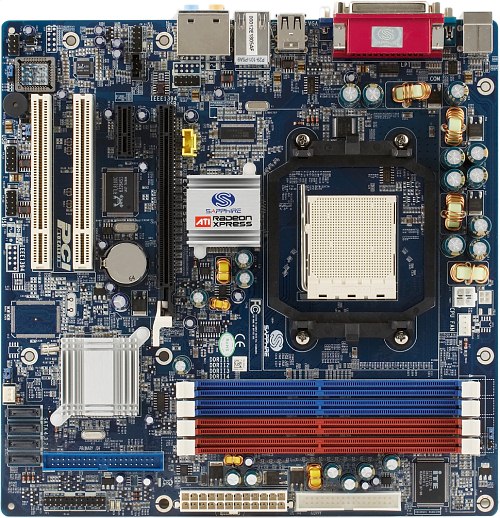 |
||
|
||
| ||
The completed merger of ATI and AMD hasn't affected the chipset line yet, if we don't take into account the forthcoming renaming of existing models. In fact, there is no urgency in renaming them. Moreover, it's not improbable that AMD will not henceforth (at least in the nearest six months) try to "beat" NVIDIA in functionality (which would have been natural of ATI) by launching chipsets under its own trademark. On the contrary, it will let it launch top chipsets for its platform. It's expedient for two reasons: Objectively, NVIDIA is the current leader (on the market of chipsets for both platforms) in the sector for enthusiasts. It's important for AMD to confirm its interest in continued cooperation with NVIDIA and strengthen its will to remain an independent player on the IT market. It does not at all mean that AMD won't launch top chipsets. But as is well known, the highest profit from non-mass products is obtained by a company that was the first to launch its product. Two months ahead is enough.
What concerns inexpensive chipsets with integrated graphics, AMD will hardly stand down intentionally here (to be more exact, it plans on catching up with NVIDIA in terms of 3D performance of the graphics core by launching #AMD 690G). But the current task is even simpler. As we don't have any gripes about the set of peripheral buses and performance of USB and SATA controllers anymore with the release of the modern Southbridge (SB600), its production volumes should be increased so that system integrators don't have shortage of motherboards with the increased production of processors. Today we are going to examine an implementation of such a chipset combo ("old" Radeon Xpress 1150 and "new" SB600) on a motherboard from Sapphire.
 We have a single remark to motherboard designers — memory latches are blocked, if you install a large video card (for example, many models from Sapphire itself.) This drawback has been already fixed by most manufacturers, including Micro-ATX motherboard. The layout of other on-board connectors (especially SATA) is very good. Passive cooling of the chipset copes with its task well. It practically does not need to be reinforced by indirect (and especially direct) air-flow, even if you plan on actively using video functions of Northbridge. However, in the latter case you'd better cool it with the air flow from the CPU cooler. The motherboard provides for a FireWire controller. The manual also mentions a modification with a gigabit network adapter. But the official Sapphire web site mentions only this modification in Pure Element series. The 3-phase switching voltage regulator of the processor incorporates two field-effect transistors per channel (half of the transistors are installed on the back side of the PCB, we have never seen this layout before), six 3300 uF capacitors and four 1500 uF capacitors. It uses Tearo capacitors (second-tier brand, on the level of OST). Motherboard dimensions — 245x245 mm (Micro-ATX), eight-screw mount, the bottom corner with SATA connectors is not secured. System monitoring (ITE IT8712F-A, according to BIOS Setup):
Onboard ports, sockets, and connectors
Back panel (left to right, blockwise) Click the image to open the rear view of this motherboard
Package Contents
Unfortunately, the bundle does not include a utility for updating BIOS and system drivers, checking for updates on the official web site. So you are recommended to use Award WinFlash to flash BIOS under Windows. Integrated Controllers
The integrated audio quality was tested in 16bit, 44 kHz using the RightMark Audio Analyzer 5.5 test application and the ESI Juli@ sound card:
General performance: Very good (details). HD Audio in this motherboard is good even against the high-quality background of modern motherboards. Settings
We used BIOS dated 22.08.06, the latest release version. The mentioned BIOS parameters are available in this version, but the viability of non-standard settings hasn't been tested. This motherboard offers quite good CPU overclocking capacities without raising CPU voltage for its class! But we expected better results from Sapphire with its exhaustive BIOS in the Pure Innovation series, especially as the segment of inexpensive motherboards with good overclocking capacities (though small, but definitely existing) is practically vacant. PerformanceTestbed configuration:
We compared the model under review with a motherboard on ATI Radeon Xpress 1150 — ECS RS485M-M.
As performance of the ECS RS485M-M in computational tests was a tad lower than standard (demonstrated by our tests), and Sapphire Pure Element allowed to set more aggressive timings in BIOS, the accumulated difference in archivers (the most sensitive tasks to memory operation nuances) is significant. However, the difference in the other tests is purely formal. ConclusionsTop Southbridge (SB600) allows to launch motherboards with modern functionality (like in NVIDIA chipsets). The famous advantage of ATI (AMD) chipsets in heat dissipation remains. Temperature of the SB600 itself even under load lets us hope for safe cooling with a compact heatsink even in mediocre PC cases with an impeded air flow. We should note that both chipset bridges return practically to the environment temperature, when the load is removed.
What can we note besides chipset peculiarities? Unfortunately, practically nothing. Sapphire launched an ordinary model, there are no proprietary technologies and interesting peculiarities (except the bundled Sapphire Select DVD). To all appearances, Sapphire counts on OEM channels to distribute inexpensive motherboards, only limited shipments will find their way to retail stores. That may not be the best choice, because Sapphire products enjoy confidence of customers. Their quality is indeed on the level of top brands, so they are really popular.
The motherboard is kindly provided by the manufacturer
Write a comment below. No registration needed!
|
Platform · Video · Multimedia · Mobile · Other || About us & Privacy policy · Twitter · Facebook Copyright © Byrds Research & Publishing, Ltd., 1997–2011. All rights reserved. | |||||||||||||||||||||||||||||||||||||||||||||||||||||||||||||||||||||||||||||||||||||||||||||||||||||||||||||||||||||||||||||||||||||||